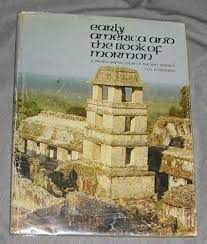Articles/Essays – Volume 08, No. 2
A Photographic Trip Through Ancient America | Paul R. Cheesman, Early America and the Book of Mormon: A Photographic Essay of Ancient America
There are beautiful pictures in this book. Some, like the take of Monte Alban at dawn, are works of art. The volume could make a valuable gift or an adequate addition to a photographical library. It provides a good substitute, or a companion, to a tour of the fallen cities that were built on the soil of the American continent long before our more recent ancestors so rudely invaded these shores.
Nevertheless, there are flaws. I mention them here only in a spirit of helpful criticism, in the hope that the author will be able to correct them in a future edition, and that other writers will avoid making the same mistakes.
Although the maps on pp. xvi, xvii and 68 are fairly accurate, those on pp. xi, xiv and 64 are atrocious. Why use bad maps when good ones are available? Furthermore, Dr. Cheesman defines “Mesoamerica” as “Mexico, Guatemala, Honduras, and Salvador” on page xiv, but the accompanying map contradicts him, as it leaves out Baja California and Honduras. The definition, at any rate, is different from the geographical one (all of Central America and Mexico) and the anthropological one (which leaves out most of Mexico and reaches down to Costa Rica).
The words “thought by some” on page xix are superfluous. It is not a matter of opinion, but a fact, that the Maya calendar was “more accurate than the Christian calendar in use at the time of Columbus.” That was the hopelessly in accurate Julian calendar. The Gregorian calendar, developed a century afterwards, is much better, but still not as good as the Maya.
Another needed correction, I’m happy to say, does not stem from an error of Dr. Cheesman’s. On page xvii, the terminal date for the peak of the “Olmec” flourishing is given as 400 B.C. However, the development of dendrochronological calibration of C-14 dates—a system that gives radiocarbon a far greater accuracy in dating than it ever had before—sets the termination at ca. 600B.C. This rein forces the view that 600 B.C. must be seen as the dividing line between the Middle Preclassic and the Late Preclassic (the chart on page x also needs correcting on this point).
Coming to Chichen Itza, Dr. Cheesman discusses the ritualistic Ball Game and correctly notes that the use of hands was forbidden, though neglecting to mention that the feet and head were also banned—making it very unlikely that the game will ever be in vogue again.
Monte Alban does not mean “sacred mountain” (p. 23). It means “white mountain.” It is regrettable that the section on Palenque (pp. 24-26) contains two photographs of the Palace (the second adding nothing to the first) but none of the interiors of the Temple of Inscriptions or the Temple of the Cross. The Teotihuacan section (pp. 38-41) omits the information that the city’s ceremonial center suffered severe destruction around 400 A.D.
Passing on to Perú, we are told incorrectly that the country’s name is derived “from a river in southern Colombia.” Actually, it is a hispanicized version of the Quichua word for “south.”
The two pages (104-105) on Petroglyphs from the continental United States come as a complete surprise, in view of the stated intention (p. xiv) to concentrate on Mesoamerica and Perú.
My main complaint, however, is that the title (though not the subtitle) of the book is misleading. Of 123 pages, only 4 have anything to say about the Book of Mormon, and what they say is not always accurate; sometimes it is even unfortunate. For instance, the statement on page 107: “The record centers around a strongly religious governing body, constantly at war with those who oppose their teachings.” Actually, the wars in the Book of Mormon were not of a religious nature, but they originated when powerful Nephite rulers made an attempt to gain even greater power by inciting Lamanites to join them in warring against their own people. Furthermore, the Nephite religious leaders were always on the defensive rather than the offensive during these wars.
Dr. Cheesman is wrong in thinking that reducing the Book of Mormon and the ancient American cultures to their lowest common denominator is proof of any sort, for that same denominator fits a number of real and imagined societies. Far more detailed and specific evidence could be provided. Indeed, from Chiapas (Zarahemla), during the centuries of the Nephite peak, there come sculptures in stone of muscular figures with trim, elegant beards and Semitic noses. This leads us to think that it can be profitable to concentrate on the times and places that best fit the background of the Nephite record.
Yet I would not over-criticize. Cheesman’s work is indeed what it announces, “a photographic essay of Ancient America,” with excellent plates that are the work of Dr. Cheesman himself. With the addition of a bibliography and the correction of the errors noted above, it could even be more than a tourist guide, and actually serve as primer for the general reader interested in Pre-Columbian archaeology.
One cannot help longing, all the same, for a comprehensive volume that would contain a scientifically sound scheme of correlation between the Book of Mormon and the culture history of the Mesoamerican Preclassic. When eventually this is provided, Book of Mormon archaeology will truly begin to exist.
Early America and the Book of Mormon: a Photographic Essay of Ancient America. By Paul R. Cheesman. Salt Lake City: Deseret Book, 1972. xiv + 109 pp. $6.95.


 Back to full Issue
Back to full Issue

